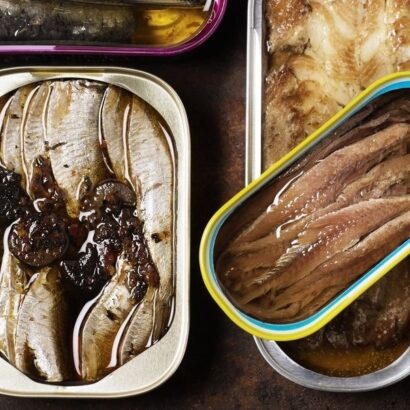In just a few years, tinned fish went from the ingredient that everybody loved to hate to an essential pantry staple. What once was an even more controversial pizza topping than pineapple is now regarded as a versatile source of savory, briny flavor. And now, you’ll find them in recipes all over the internet. You can blame Alison Roman, or write it off as a recession food trend, but tinned fish is here to stay.
The average shopper is familiar with tuna, but there’s a wide variety of seafood sold in a can. You can find mussels, mackerel, salmon, and even octopus in tiny shelf-stable tins. But two of the most accessible and multipurpose varieties are anchovies and sardines.
These fish are both small, fatty, and salty. And many people are not fans, calling them stinky and too fishy. But sardines and anchovies have a wide range of applications that are seriously delicious.
More From Delish

That being said, they are not the same. So we’re breaking down all of the differences between these two types of fish. Here’s what makes sardines and anchovies unique—from flavor, to size, to how to use them in recipes. So whether you’re a tinned fish skeptic or want to experiment with the ingredient, you can go to the grocery store equipped with all of the knowledge you’ll need.
What Are Anchovies?
Anchovies are tiny fish that live in salt water. They rarely exceed seven inches in length and have small, barely noticeable scales. Originating in the Mediterranean and Black seas, anchovies are now found all over the world and are processed in multiple different ways.
The most common anchovies you’ll find at the grocery store are fillets packed in oil. During processing, whole anchovies are broken down to remove the head, guts, and fins. Then they’re packed in salt and cured, which draws out the moisture and preserves them. This is also where they can develop their signature funky smell. From there, they’re washed and cut down into boneless, spineless fillets, then packed into jars or tins with oil.
You may also find salt-packed anchovies, which are whole and need to be rinsed and deboned. Dried whole anchovies are especially popular in East Asian cuisines (in Japan, it’s often used as the base for broths or simply eaten as a snack). And boquerones, a Spanish delicacy, are anchovies preserved in vinegar instead of salt. They’re much milder than their salt-cured counterparts and are commonly served as tapas.
There’s also anchovy paste; but whatever you do, don’t buy it. It may seem easier than chopping up a filet, but the added preservatives and strange flavor aren’t worth the convenience.
For the majority of cooking projects, oil-packed fillets are your best option. When cooked down in more oil, like in our Garlicky Spaghetti recipe, they melt into your sauce and lend a umami-forward flavor (without tasting fishy). When mashed up and combined with plenty of other ingredients (like a Caesar salad dressing, for instance), it’s like using an upgraded version of salt.
Many tinned fish enthusiasts argue that anchovy haters are simply buying the wrong brands. And in their defense, quality definitely goes a long way. Good anchovies are plump, meaty, and more mild in flavor. Here are some of our favorites:
What Are Sardines?
Sardines are from the same family as anchovies and bear a striking resemblance to their tiny relatives. The diminutive fish can be found in just about every ocean. They range in size depending on where you catch them, but are generally between six and 12 inches and noticeably bigger than anchovies.
What makes the average canned sardine different from an anchovy is its preparation methods. Rather than filets, you’ll usually find sardines packaged whole (head, fins, and guts removed). So each fish will come with its skin and bones intact. But don’t be nervous: they’re so soft and delicate that you can eat them easily.
Canned sardines can also be super versatile flavor wise. Depending on the brand you buy, they can be packed in oil, water, tomato sauce, and more. Some are even smoked. No matter how they’re processed, sardines are an oily, fatty fish that has a strong fishy flavor. While you can absolutely cook with them, sardines are especially delicious as a snack, layered on a piece of buttered toast.
Editorial Assistant
Gabby Romero is Delish’s editorial assistant, where she writes stories about the latest TikTok trends, develops recipes, and answers any and all of your cooking-related questions. She loves eating spicy food, collecting cookbooks, and adding a mountain of Parmesan to any dish she can.









